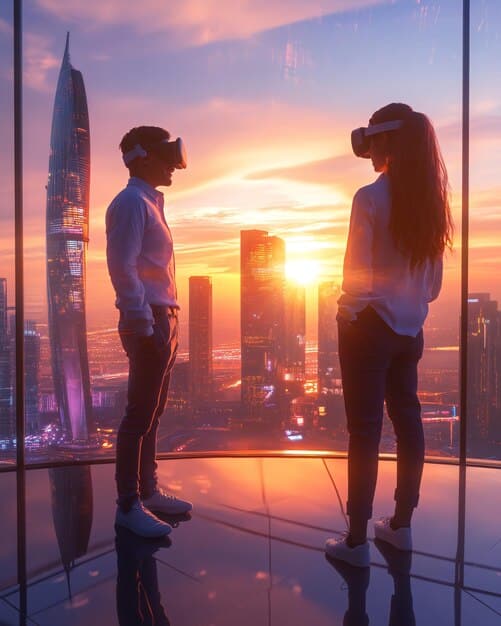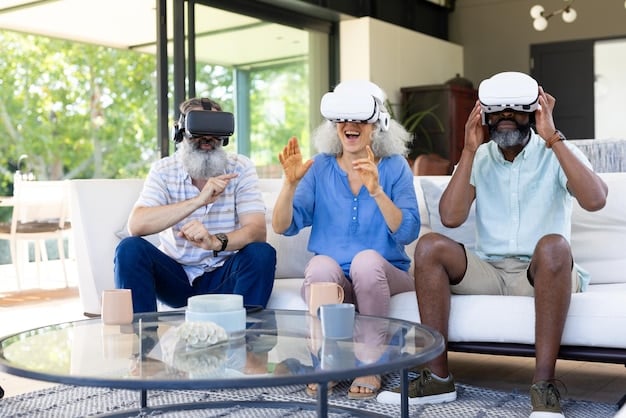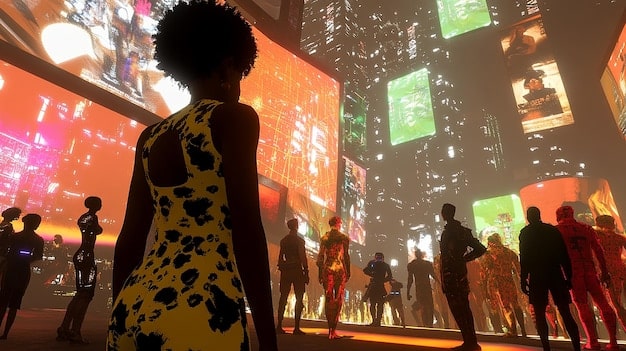The Metaverse in the US: Transforming Work and Social Life

The metaverse is poised to significantly impact the future of work and social interaction in the US, offering immersive experiences that blend the physical and digital worlds, reshaping how Americans connect and collaborate.
The advent of the metaverse is not just a technological evolution; it’s a potential revolution in how we conduct our professional lives and engage socially in the US. As we stand on the cusp of wider adoption, understanding **how will the metaverse impact the future of work and social interaction in the US** becomes crucial for individuals, businesses, and policymakers alike.
The Rise of the Metaverse: A New Reality for the US?
The metaverse, often described as a persistent, shared virtual world, has captured the imagination of technologists and the general public alike. But what exactly is it, and why is it gaining so much traction in the US right now?
The metaverse isn’t just about virtual reality (VR) or augmented reality (AR); it’s a convergence of technologies that create immersive digital experiences. Imagine attending a business meeting in a virtual office, collaborating with colleagues on a 3D design in real-time, or socializing with friends in a virtual concert—all from the comfort of your home in the US.
Key Components of the Metaverse
Several technologies underpin the metaverse, making it more than just a buzzword:
- VR and AR: These technologies provide the visual and interactive interfaces for users to enter and interact with the metaverse.
- Blockchain and NFTs: Blockchain technology enables secure digital ownership and transactions within the metaverse, with NFTs (Non-Fungible Tokens) representing unique digital assets.
- Artificial Intelligence (AI): AI powers many aspects of the metaverse, from creating realistic avatars to moderating virtual environments.
The potential of the metaverse to transform various sectors is vast, particularly in the context of work and social engagement in the US.
In conclusion, the metaverse represents a significant shift in how we perceive and interact with technology, offering new possibilities for both work and social interaction in the US.
Transforming the Future of Work in the US
The metaverse is poised to revolutionize the way Americans work, introducing new paradigms for collaboration, training, and productivity. How will these changes affect the US workforce?
One of the most significant impacts of the metaverse on work is the potential for enhanced remote collaboration. Virtual workspaces can simulate the experience of being in a physical office, fostering a sense of presence and camaraderie among remote teams in the US.

Enhanced Collaboration and Communication
The metaverse enables real-time interaction and collaboration in shared virtual environments. This can lead to:
- Improved Teamwork: Tools that facilitate shared design, brainstorming, and problem-solving in virtual spaces.
- Reduced Communication Barriers: Overcoming geographical constraints, allowing teams from different parts of the US to collaborate seamlessly.
- Increased Engagement: Interactive and immersive experiences that keep employees engaged and motivated.
Beyond collaboration, the metaverse can also transform training and development programs. Virtual simulations offer risk-free environments for employees to learn new skills and practice complex tasks.
In summary, the metaverse has the potential to revolutionize the workplace, enhancing collaboration, and boosting productivity in the US.
Reshaping Social Interaction in the US: Connecting in New Ways
Beyond the workplace, the metaverse is set to redefine social interaction in the US, creating new avenues for connection, entertainment, and community building. How will Americans adapt to these new social landscapes?
The metaverse offers unprecedented opportunities for social connection, allowing individuals to interact with others from around the globe in shared virtual spaces. Whether attending a virtual concert, exploring a virtual art gallery, or simply hanging out in a virtual café, the metaverse can foster a sense of community and belonging.
New Forms of Entertainment and Leisure
The metaverse is opening up new possibilities for entertainment and leisure activities, including:
- Virtual Events: Attending concerts, festivals, and sporting events in immersive virtual environments.
- Gaming and Interactive Experiences: Engaging in collaborative gaming experiences with friends and strangers around the world.
- Virtual Tourism: Exploring virtual replicas of real-world locations or venturing into entirely fictional worlds.

However, the integration of the metaverse into social life also raises important questions about identity, privacy, and online safety. Creating safe and inclusive virtual environments will be crucial to ensuring that the metaverse benefits all members of society in the US.
In conclusion, the metaverse is poised to reshape social interaction in the US, offering new ways to connect, engage, and build communities.
Addressing Challenges and Concerns in the US Context
While the metaverse offers immense potential, it also presents several challenges and concerns that need to be addressed, particularly within the US context. What are the key hurdles to overcome for widespread adoption?
One of the primary challenges is ensuring accessibility. The cost of VR/AR headsets and other necessary equipment may create a digital divide, excluding low-income individuals and communities in the US from participating in the metaverse.
Key Challenges and Concerns
Several challenges need to be addressed to ensure the metaverse is inclusive and beneficial for everyone in the US:
- Accessibility: Addressing the digital divide and ensuring that everyone has access to the necessary technology.
- Privacy and Security: Protecting users’ personal data and preventing identity theft and fraud.
- Mental Health: Addressing potential negative impacts on mental health, such as addiction and social isolation.
Another concern is the potential for misuse and abuse within the metaverse. Addressing these issues will require a collaborative effort involving technology companies, policymakers, and community organizations in the US.
In summary, addressing the challenges and concerns associated with the metaverse is essential to ensuring its responsible and equitable development in the US.
The Role of Technology Companies and Policymakers in the US
The development and governance of the metaverse will require collaboration between technology companies and policymakers in the US. What roles do these stakeholders play in shaping the future of this technology?
Technology companies are at the forefront of developing the technologies and platforms that power the metaverse. They have a responsibility to ensure that these technologies are safe, secure, and accessible to all Americans.
Collaboration and Regulation
Effective regulation and collaboration are crucial for the responsible development of the metaverse in the US:
- Standards and Interoperability: Promoting open standards to ensure that different metaverse platforms can interact seamlessly.
- Ethical Guidelines: Establishing ethical guidelines for the development and use of AI and other technologies within the metaverse.
- Consumer Protection: Protecting consumers from fraud, scams, and other online harms in virtual environments.
Policymakers also have a crucial role to play in setting the rules of the road for the metaverse. Addressing these issues proactively will help ensure that the metaverse is a force for good in the US.
In conclusion, the responsible development and governance of the metaverse require collaboration between technology companies, policymakers, and other stakeholders in the US.
Predictions for the Metaverse in the US: What to Expect
As the metaverse continues to evolve, what can we expect to see in the coming years in the US? What are the key trends and developments to watch?
One likely trend is the increasing integration of the metaverse into everyday life. As technology becomes more affordable and accessible, we can expect to see more Americans using the metaverse for work, social interaction, entertainment, and education.
Future Trends and Developments
Several trends and developments are likely to shape the future of the metaverse in the US:
- Advancements in VR/AR Technology: More affordable and user-friendly VR/AR headsets with improved graphics and haptic feedback.
- Increased Interoperability: Greater connectivity between different metaverse platforms, allowing users to move seamlessly between virtual worlds.
- Expansion of Metaverse Applications: New use cases for the metaverse in industries such as healthcare, education, and retail.
However, it’s important to remember that the metaverse is still in its early stages of development. Monitoring these trends and developments will be crucial for understanding the full potential of the metaverse in the US.
In summary, the metaverse is poised to become an increasingly integral part of American life, with significant implications for work, social interaction, and beyond.
| Key Point | Brief Description |
|---|---|
| 🏢 Future of Work | Enhanced remote collaboration and improved training programs using VR/AR. |
| 🫂 Social Interaction | New avenues for connection via virtual events, gaming, and virtual tourism. |
| 🚧 Challenges | Addressing accessibility, privacy, security, and mental health concerns. |
| 🏛️ Roles | Collaboration between tech companies and policymakers for responsible development. |
FAQ Section
▼
The metaverse is a persistent, shared virtual world that combines elements of virtual and augmented reality with social interaction. It aims to create immersive digital experiences.
▼
The metaverse can enhance remote collaboration by providing virtual workspaces that simulate physical offices, fostering better teamwork and communication among distributed teams.
▼
Potential risks include privacy concerns, security vulnerabilities, mental health impacts like addiction, and the exacerbation of social isolation if not used responsibly.
▼
To address the digital divide, affordable access to VR/AR equipment and high-speed internet is crucial. Government and community initiatives can help provide resources and training.
▼
Policymakers are essential for setting regulations and standards that ensure consumer protection, data privacy, and ethical guidelines for the development and use of technologies within the metaverse.
Conclusion
In conclusion, the metaverse holds transformative potential for the future of work and social interaction in the US. While challenges and concerns exist, addressing them proactively through collaboration between technology companies, policymakers, and the public can pave the way for a more inclusive and beneficial virtual future.





